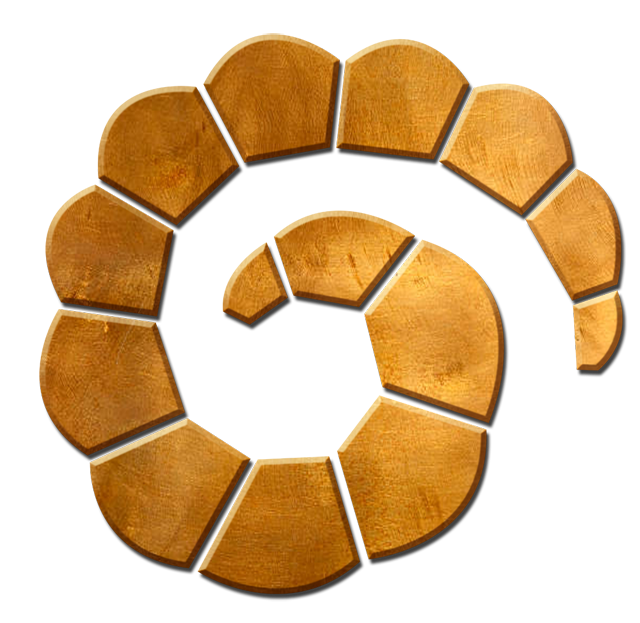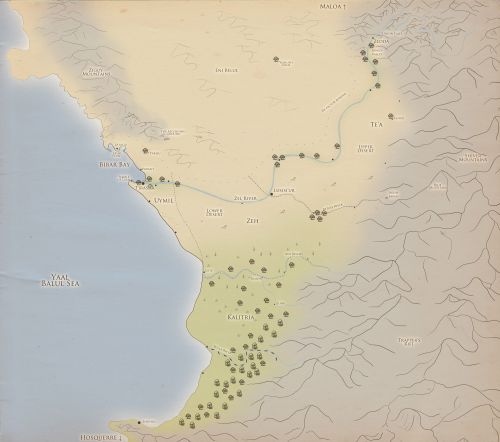Kingdom of Tanish
Physical Geography
The Kingdom of Tanish is centred along the Zel river, which runs from east to west from the Shiver Mountains to the sea at Bibar Bay. The river is the dividing line between the sea of sand dunes in the heart of the desert and the more livable southern edge. Along the river's banks, fertile ground, trees, and reeds flourish, making agriculture possible. To the north, the fertile ground gives way to the Eni Belul Desert, a name which means "second sea". There is very little solid ground, hardly any sources of water, and dangerous creatures lurking among the dunes. Crossing it is perilous. South of the river, the desert is hard and rocky. There are very few settlements away from the coast or river, or along the Retays River, a small tributary of the Zel. The rocky desert eventually gives way to warm, dry savanna with sparse trees and long grass. The more south you go, the more Mediterranean the climate gets, with palm trees replaced by olive trees and more frequent rain. Tanish controls the land to the southernmost river, leaving a pocket of unclaimed territory as a buffer between them and Hosquerre. In the northeast, the Zel flows out of the valley in the mountains, after coming down a waterfall. This valley, the Valley of Kings, is mostly dry and sandy with greenery just along the banks of the river.Political Geography
Tanish's north border is not clearly defined. They rule as far north into the desert as they can exert control. Caravans coming from the north know they've entered Tanish when they start seeing soldiers round. To the east, they are bound in by the Shiver Mountains and to the west, the coast. Large parts of the desert south of the Zel but north of the savanna are controlled only in theory, but in practice hardly anyone lives there. The southern border is the Willa River. The official stance of the government is that they chose to have a buffer zone between themselves and Hosquerre, but in practice, they failed to conquer the more heavily wooded part of southern Kalitria due to the troops being accustomed to the flat, open desert. Tanish is divided into 4 provinces: Uymil along the coast, Zeh in the centre with most of its population concentrated in the savanna, and Te'a east of the Retays River which consists mostly of desert and is the least populated, but contains the capital. The 4th province is Kalitria, which was taken in conquest and does not have the same rights as the Tanishite states. The southern border is heavily guarded to prevent Kalian people from fleeing to the unconquered portion of Kalian territory.International Relations
Tanish has relatively good international relations. Their location is rather isolating due to the extreme desert to the north, so they have little fear of military attack. The kingdom to the north, Maloa, is a valued trade partner, although it is probably only the inhospitable desert that has kept these kingdoms from intruding on the others' territory. Directly south of them are the Kalian tribes, which are united under the Kalian Confederacy. Due to the war, seizure of territory, and oppressive treatment of Kalian people now living under Tanishian rule, relations with the Confederacy are dismal. The southern border along the river is heavily fortified and both groups have an embargo against the other's goods. It is probably only a matter of time before they orchestrate another attack to take the rest of the region. Their best friend is probably Hosquerre. They are both isolated kingdoms in arid regions who share a lot of common cultural background, e.g., their gods are very similar and they eat a lot of the same foods. Due to both the Kalian Confederacy between them and Hosquerre's closed borders, contact with Hosquerre is only done by ship. But, they do maintain a diplomatic presence in Tamanhami and Hosque diplomats are always received much better than those from Maloa. The mountain range between them means they have very little direct contact with the Taalorang Empire, with most trade going through Maloa or Hosquerre first. Most people only know it as someplace that's large, very foreign and far away, and the source of exotic art and silk.Structure
The king of Tanish takes the throne upon his death, once he has lived a full life to gain enough perspective to rule. Once dead, he communicates his wishes to the Oracle via dreams. His heir, the prince, becomes the Great Prince. Once sworn in as the Great Prince, he will become the king as soon as he dies. While alive, the Great Prince is sworn to carry out the will of his father. The Great Prince is also the high priest.
- Eldest son
- Any younger son order of age
- Nephews on the king's brother's side
- Nephews on the king's sister's side
- Daughters of the king
- Nieces
Laws of Inheritance
The king's right to rule comes from his divine ancestry. Maintaining that direct link to the sun is of utmost importance. Men also have priority over women in all matters of inheritance. The order of inheritance is:Assets
History
Maps
-
Map of Tanish
Map of the Tanish Kingdom and surrounding area, including the desert to the north, the Kalitrian region, and northern tip of Hosquerre.




